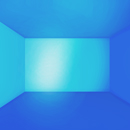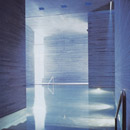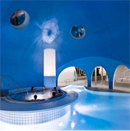
Blue Moon
Blue Moon describes a space filled with blue light. Blue Moon is a subset of Color Flood. more
Blue Moon | Resort & Spa
application
Blue Moon in resorts and spas describes a space filled with a neon blue light that creates a sensation of submersion in water. It is often used in spaces where physical water is absent.
research
The prolific use of blue light in resort and spa interiors is considered a positive stimulation, as it echoes the cleansing properties of water. In Ayurvedic medicine, a holistic approach often utilized in New Age spa facilities, turquoise and aquamarine shades are associated with the regulation of the immune system, namely the quelling of infections and ailments. The nude body and mind are most open to absorb the restorative properties of blue pigment and light, as illustrated by the use of blue in spa and resort environments. The color element of Blue Moon existed prior to the employment of electric light, as rich tones of blue were commonly used in interiors dating back centuries. Because of the quick vibration and short wavelengths of the color blue, it is associated with airiness and fluidity, calm and tranquility, as “time is perceived as passing more slowly in a blue room.”1 Washes of blue are thus utilized most often in interiors that attempt to alleviate stress and impart relaxation and serenity. Furnishing spaces in blue was an early strategy of creating calm interiors that were used for leisure.
The Chiswick House, built and owned by Lord Burlington c1730, is one of the earliest recorded interiors to feature an entirely blue room, aptly titled the Blue Velvet Room. The walls, ceiling, and furniture of the room were swathed in blue velvet, and the three windows were dressed with sapphire-hued window treatments. It is surmised, based on the size of the room and the texture and color of the furnishings that “the Blue Velvet Room probably served as a private study and meeting place for Lord Burlington’s close friends.”2
The notion of filling space with a blue hue was further developed during the early 20th century, as bathhouses were reestablished as public centers of health and rejuvenation. Architects George Mann and Eugene John Stern introduced “an enormous skylight with art glass panels in an aquatic motif” to the Fordyce Bathhouse during its 1915 renovation.3
Although stained glass was discovered much earlier, the size and tone of the skylight filtered sunlight in a manner that filled the space with blue-tinged light, effectively setting the precedent for contemporary Blue Moon interiors.
The desired effect of blue light-filled rooms was later captured and manipulated, particularly during the Art Deco movement of the 1930s, as designers began to explore the concealment of lighting in soffits and ceilings, utilizing indirect lighting to create a glowing effect. The advent of neon lighting, previously used only in signage, began to intermix with incandescent lighting to create decorative effects.4
The enticement and fluidity of blue light further captured the attention of artists and designers during the mid-20th century, as the light was harnessed as a method of spatial intervention. A 1970 installation by artist Dan Flavin, Untitled (to Marianne), captured the quality of blue fluorescence, as “the horizontal bands of blue light appear to liquefy the floor. Flavin’s installation simply, yet powerfully, envelops the viewer with the ambient effects of color and light.”5
The prolific use of blue light in resort and spa interiors is considered a positive stimulation, as it echoes the cleansing properties of water. In Ayurvedic medicine, a holistic approach often utilized in New Age spa facilities, turquoise and aquamarine shades are associated with the regulation of the immune system, namely the quelling of infections and ailments. The nude body and mind are most open to absorb the restorative properties of blue pigment and light, as illustrated by the use of blue in spa and resort environments.6
In areas where water is absent, such as guest rooms, lounges and reception areas, the use of blue light suggests the healing properties of relaxation, often foreshadowing the physical and mental treatments that a patron may experience while in the spa. Shades range in Blue Moon from medicinal turquoise to luxurious cobalt and theatrical violet, imparting the purpose and desired effect of the space. In some instances, several shades of blue light are used, as discovered on a site visit to Red Rock Resort and Spa (2006) in Las Vegas; the spa corridor is lit solely by daylight and variable blue accent lighting from beneath a water feature. As the corridor is a transition zone between the locker rooms and treatment rooms, differing blue hues are used to convey past and present experiences within the spa. Blue Moon is a powerful intervention to interior space that effectively quells stress and transports the mind and body through a haven of spatial serenity.
The chronological sequence for contemporary Blue Moon in resorts and spas begins in 1991 with a restaurant in the Resort at Squaw Creek, Lake Tahoe, California and continues steadily through 2008.7
end notes
- 1) Robert F. Ladau, Brent K. Smith, and Jennifer Place, Color in Interior Design and Architecture (New York: Van Nostrand Reinhold, 1989), 86.
- 2) T. S. Rosoman, “The Decoration and Use of the Principal Apartments of Chiswick House, 1727-70,” The Burlington Magazine 127, no. 991 (Oct. 1985), 668.
- 3) John C. Paige and Laura Soulliere Harrison, Out of the Vapors: A Social and Architectural History of Bathhouse Row: Hot Springs National Park, Arkansas (Washington, D.C.: U.S. Department of the Interior, National Park Service, 1988), 191.
- 4) John Pile, A History of Interior Design (New Jersey: John Wiley & Sons, 2005), 360.
- 5) Anne Farrell, ed., Blurring the Boundaries: Installation Art 1969-1996 (San Diego: Museum of Contemporary Art, 1997), 43; Lounge, Zenana [2005] Joseph Sy and Associates; Hong Kong in Spa Design (Koln: Daab, 2006), 334; Lounge, Naples Grand Resort and Club [2007] Barry Design Associates; Naples, Florida in "Aural Fix," Hotel Design Magazine (April 2007), 10-14.
- 6) Catherine Cummings, Color Healing Home (London: Mitchell Beazley, 2000), 66.
- 7) Rachel Goldfarb, Site Visit, Red Rock Resort and Spa, Las Vegas, NV (March 2008).
- 8) Evidence for the archetypical use and the chronological sequence of Blue Moon in resort and spa was developed from the following sources: 1990 Restaurant, Resort at Squaw Creek [1991] SMWM; Lake Tahoe, CA in "A Timeless Resort," Interiors 150, no. 15 (Oct. 1991): 70-71; PhotoCrd: Chas McGrath; Indoor Pool, Therme Vals [1996] Peter Zumthor; Vals, Switzerland in "Primal Therapy," Architectural Review 202, no. 1206 (Aug. 1997): 45-49; PhotoCrd: Henry Pierre Schultz / 2000 Pool, Black Spa [2000] Wolfgang Poschol, Thomas Thum, Architect; Kitzbuhel, Austria in Alejandro Bahamo´n, New Hotels (New York: Harper Design International, 2003), 101; PhotoCrd: Paul Ott; Spa, Dusseldorf Seestern [2001] Schneider and Schumacher; Germany in Paco Asensio, ed. Ultimate Hotel Design (Barcelona: LOFT Publications, 2004), 335; PhotoCrd: Jorg Hempel; Spa, Boscolo Hotel Aleph [2003] Adam Tihany; Rome, Italy in Edie Cohen, "Sinfully Luxurious," Interior Design 74, no. 12 (Oct. 2003): 232; PhotoCrd: Ken Haydn; Corridor, Blue Medical Beauty Spa [2004] Michael Marquez; Sherman Oaks, CA in Michael Reinhardt, Spa Design (Kohn: Daab, 2006), 188 in photograph by Rachel Goldfarb on location [2008]; Pool, Bath Spa [2006] Nicholas Grimshaw + Partners; Bath, UK in "Bath Spa," Architectural Record 192, no. 2 (Feb. 2004): 119; PhotoCrd: Edmund Summer, View Pictures; Pool, Therme Bad Aibling [2007] Behnisch Architekten; Bad Aibling, Germany in Mairi Beautyman, "Bubble Bath," Interior Design 79, no. 2 (Feb. 2008): 184-187; PhotoCrd: Torben Eskerod and Adam Mark.
bibliographic citations
1) The Interior Archetypes Research and Teaching Project, Cornell University, www.intypes.cornell.edu (accessed month & date, year).
2) Goldfarb, Rachel. “Theory Studies: Archetypical Practices of Contemporary Resort and Spa Design.” M.A. Thesis, Cornell University, 2008, 60-66.


